MAPP NM-SPG = Transmission
November 30th, 2005
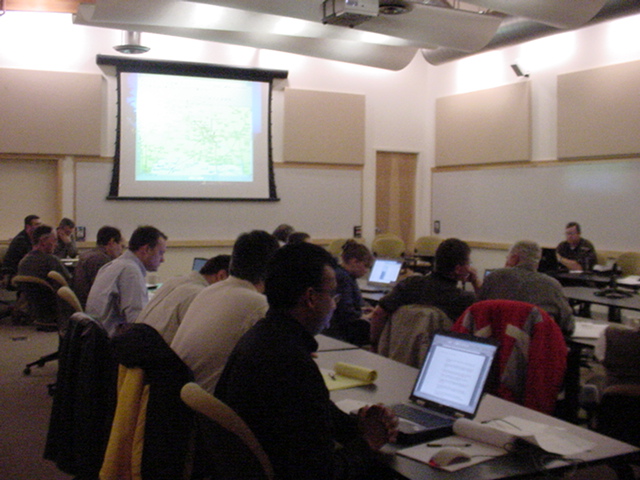
Today was the MAPP SPG meeting, I guess it’s technically MISO now, but everyone calls it MAPP. This is where it’s decided how to make the wishes of those with the power happen. There is a distinction between the policy promotion of transmission , i.e., whether we’ll have distributed and dispersed generation or central station power, and the technical problems such as overloads, impacts of connecting generation on the system as a whole. This group deals with the technical problems, calling them to the group’s attention and banding together to figure out a fix. In this respect, it is all connected. But because it’s all connected, this is also the venue where the policy doesn’t always agree with the laws of physics, yet engineering brains are trying to make it happen, yielding occasional “OH SHIT!” moments!
For example, today we talked about the “northern loop” problem, which is the 10% or so of the Buffalo Ridge wind energy that is shooting up to Dorsey, Montana, then over to the Forbes substation, and then down to the Chisago sub — by that time, given line losses, there’s probably nothing left! Here’s what the report says:
… it is observed that whatever transmission Option were implemented, approximately 4-5% of the SW Minnesota –> Twin Cities/Milwaukee power delivery flows northward to Manitoba on the Rugby-Glenboro and Letellier-Drayton 230kV lines, and then southward on the Dorsey (Riel) Roseau Co-Forbes-Chisago Co 500kV.
It’s 200MW over limits and gets worse as the level of export from North Dakota goes up. What to do? Well, they don’t quite know yet, but here’s what they’re looking at:
* Phase Shifting Transformers — VERY EXPENSIVE – $5-8 million
* Lower impedence of new 345kV line – solves problem by directing more electricity through 345kV line because more here = less there, and also decreases line losses on 345kV (no cost provided)
* Increase 500kV loadability – with capacitors, the rating could be increased over 400 MVA — also $5-8 million
This Manitoba wind problem is a good example of why it’s not very bright to be shipping electricity over long distances — there are so many variables to account for, and where we’re dealing with a generation source with a 41% capacity factor, and assuming at least 30% line losses before it gets to where it’s going, if everything goes right, this is about the least efficient and most wasteful way to supply electricity.
Here’s another example, imagine Mesaba, cranking away producing electricity. They put it on the line, and it goes out into the world toward a “sink” end point, and guess what?
The transfer analyusis indicated that, excluding pre-existing constraints, the proposed facilities would be limited to less than 90 MW in deliveries to Xcel Energy for the indicated sinks.
Translation – they’re sunk – they can’t get the power to the sink! To find this glorious sentence, go to the MISO queue and scroll down to project number 38280-01, the Mesaba project, and then scroll way right and click on X2.
Watching paint dry? I think not!

I thought Ray’s blog sounded familiar…
November 30th, 2005
I read Ray Cox’s blog today and it had a familiar ring to it. Ray’s blog post at 6:49 a.m. says:
Earlier this week at the UofMN’s Initiative for Renewable Energy and the Environment’s Second Annual Research Symposium, Governor Pawlenty reiterated his goal to have Minnesota utilities install 800 MW of community-based wind energy projects by 2010. The Governor first announced this goal in a speech to the Agri-Growth Council on November 8th. That would result in over a billion dollars of wind energy investment in Minnesota’s rural communities and farm economies in the next five years. Iâ??m very pleased that Governor Pawlenty has a solid commitment to wind energy.
That IREE conference was yesterday, and he missed Pawlenty’s speech and Steven Taff’s presentation of Transition Roadmap Toward a Carbon-neutral Energy System for the Upper-Midwest Region, a project he said was funded by the Waltons and ME3.
Anyway, back to business, Ray’s post sounded familiar, and sure enough, here’s an email Mikey Bull sent yesterday at 5:36 p.m.:
FYI — Today at the UofMN’s Initiative for Renewable Energy and the Environment’s Second Annual Research Symposium, Governor Pawlenty reiterated his goal to have Minnesota utilities install 800 MW of community-based wind energy projects by 2010. The Governor first announced this goal in a speech to the Agri-Growth Council on November 8. That would result in over a billion dollars of wind energy investment in Minnesota’s rural communities and farm economies in the next five years.
As Ray said in an interview with Jeffrey Hill:
RC You can’t be boring….short, to-the-point blogs work best. And you absolutely cannot have someone else write for you…that is always “outed” and people feel very betrayed.
Ray, you be outed — you can’t steal from others! Last time I caught him, and I confess I’ve not been watching closely, he cut and pasted from the Gov’s website and some other site, and it was published as his work in a “Guest Column” in the Northfield News, the majority was taken verbatim and there was no attribution. People get booted out of college, denied admittance to the bar for this. I guess it’s different in construction… and the legislature…
STOP CUTTING AND PASTING AND START CITING YOUR SOURCES!
434th Chemical Company is back – let’s bring them all home!
November 29th, 2005
They’re back!
For the last week, there have been “Welcome Home” signs all over Red Wing, and yesterday yellow ribbons went up on every streetlight and phone pole and tree in town. They went through Northfield earlier in the day, reported by Scott Davis on Northfield.org. The 434th Chemical Company arrived in town from Iraq. As I came back from a dog food run, and running the dogs, in the 45 minutes or so that I was gone, Hwy. 61 was dotted with people with big signs and flags, at one a 4×8 recycled campaign sign, “Henry says Welcome Home!” (or was it Harvey?). As I was digging around on the computer, I noticed a flash on the Red Wing paper site that they’d left Cannon Falls at 2:20, and it was 2:47, so I decided to go over to the Armory. It was quite a production, cop cars, highway patrols, at least 20 cars escorting the busses, and they alterted the dogs who said to get moving. The Red Wing fire truck had the flag held over the driveway.
In this photo, note the woman in the center, Rebecca Leja, scanning the room with that “where are they?” look.
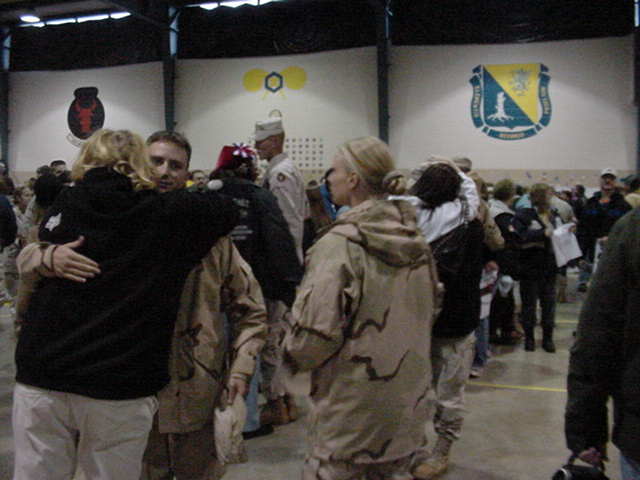
But check the front page of the RW Republican Eagle for the happy reunion!

Caption from Red Wing Republican Eagle: Rebecca Leja is reunited with her English bulldog, Gizzard, on the floor of the Red Wing Armory. The 434th arrived shortly after 3 p.m. Tuesday afternoon to the joy of the soldiers and family members. — staff photo by Kevin Macdonald
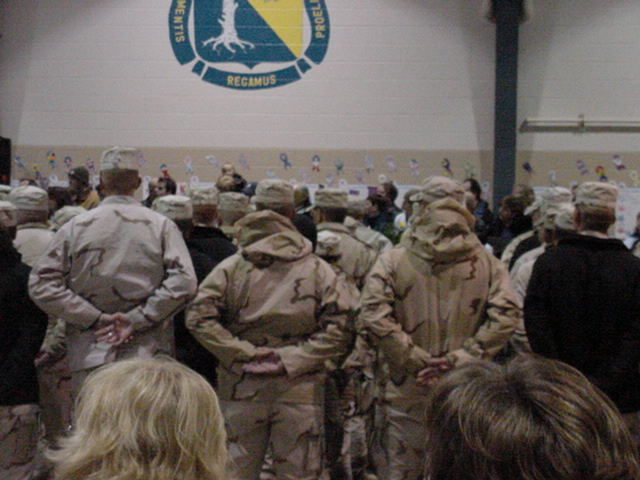
BRING THEM ALL HOME — NOW!!!
Ethanol in the news again…
November 29th, 2005

I must confess I don’t know a lot about ethanol, other than Pawlenty is utilizing it to tout himself as the “environmental Governor” (urp), and from the MAPP meetings I know that every time an ethanol plant is built there’s an issue about electrical service to the site, the load is so large that it alters load shapes for the area and there’s new infrastructure necessary. Today it’s in the STrib again:
Once just a kernel of innovation, ethanol industry now popping
Corn-based fuel is becoming the United States’ front-runner alternative to imported oil.
In the article, there’s info about fueling the ethanol making process:
A cooperative in Little Falls, Minn., is spending $8 million so it can make ethanol by burning scrap wood instead of more expensive natural gas…
The Central Minnesota Ethanol Co-op in Little Falls is building huge bins to hold 1,200 tons of timber cuttings, storm-damaged trees and scrap wood that will replace natural gas as its energy source, said Kerry Nixon, the plant’s general manager. He contends the plant will burn “waste energy” and create three units of energy for every unit of fossil fuels burned. The excess steam will be harnessed to create a megawatt of electricity, and a new thermal oxidizer will burn most of the pollutants, he said.
Can someone explain why they can’t use ethanol as the fuel rather than natural gas?
Here’s another today from the Mankato Free Press: Flexible Fuel
And what is BP up to? This is too vague…
BP plans alternative energy firm

BS II – the line to nowhere
November 27th, 2005
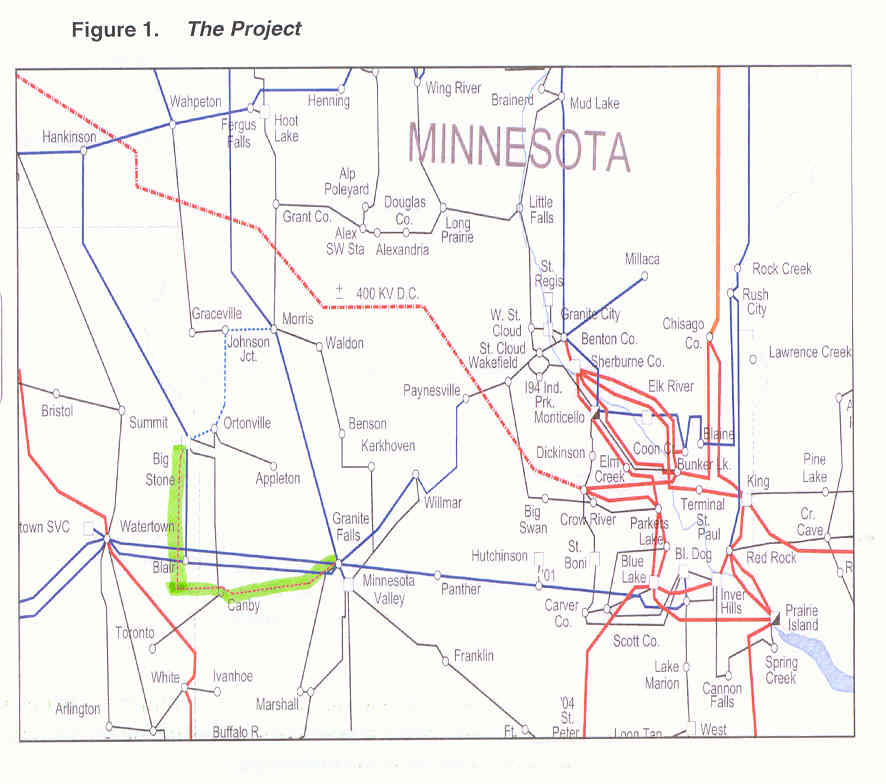
See the part highlighted in green? That’s the Big Stone II transmission project as applied for — see why I call it BS II? It’s a line from the plant to the middle of nowhere (no offense to Granite Falls!). As the industry is so busy explaining to us, the grid is an interconnected system. A line from somewhere to nowhere, a radial line like this one, according to the industry, is a reliability risk, it’s not stable. Yet that’s what they want to do, run a big line to nowhere. Uh-huh, yup, sure…
Oh, but there’s more — as they say in the BS II Application, p. 3:
When operated at 345kV, the Granite Falls line will act as the first phase of a 345kV transmission plan connecting western/southwestern Minnesota to the Twin Cities.
Well, DUH, we know it’s all connected. Here’s what they’re building looks like, in toto:
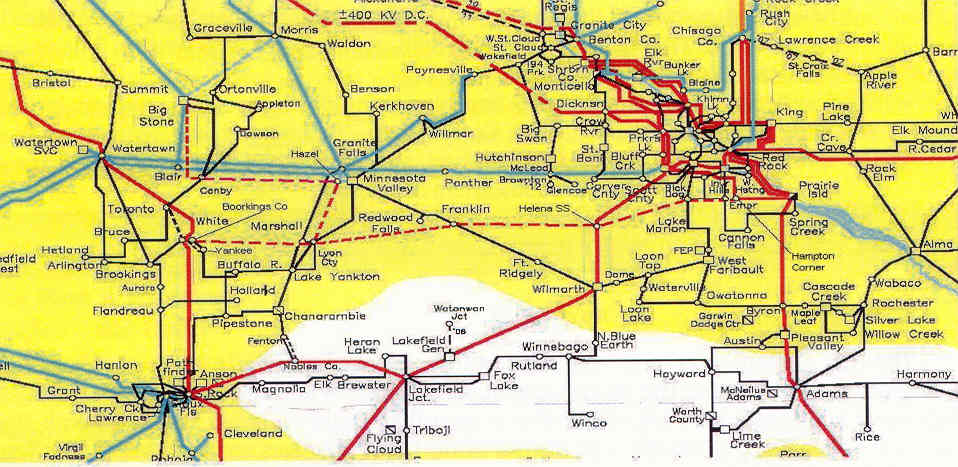
The red dashed line is the entire project, a system, as the application states. Without the entire project, BS II electricity doesn’t get where they want it to go.
How does MTEP06 describe this segment? Look at section 6.1, point 2:
2. Belfield, North Dakota (site of a new 500 MW coal plant) to Ellendale, South
Dakota to Big Stone area to Granite Falls to Blue Lake, Minnesota
… let me see if I understand the MTEP plan, the Belfield’s connected to the Big Stone, the Big Stone’s connected to the Granite Falls, the Granite Falls’ connected to the Blue Lake… and we’re at the MNEX electrical turnabout to shoot electricity out to the east and south!
… now this BS II Application… let me see if I understand the BSII Application… The Big Stone’s connected to the Granite Falls… CONNECTUS INTERRUPTUS! DUH, something’s missing…
**************************************************************
December 1 is the PUC meeting on the completeness of the Big Stone II transmission line.
Here’s the Staff Briefing Papers, and here’s their summary of my Comments:
Initial Comments of Carol A. Overland
Carol Overland argued that the Application in not complete in at least three major respects:
The entire project is not described. A 345-kV line does not go from a large power plant to the middle of nowhere. The 345-kV line is a part of a much larger project, including the Belfield, North Dakota coal plant and continuation of the line to the Twin Cities area.
There is no explanation of how the power gets to the utilities who are claiming need. There must be a demonstration of how the project, or an expanded project, fulfills the need claimed for electricity.
Any deals that have been made relevant to this project must be included. A South Dakota newspaper alluded to certain deals to benefit wind power. Relevant deals must be filed with the Commission and scrutinized for impacts beyond the parties.
And here’s what BSII has to say about that:
In response to the comments of Carol A. Overland, the Applicants indicated:
There is absolutely no precedent in law–or in how the system operates–for the
Commission to delay action on this proceeding in order to wait for additional facilities
that might be proposed later. While Applicants and other utilities are working toward
proposing other 345-kV facilities, the proposed project remains a stand-alone project.The Application is ripe with data and information on how the proposed project meets the
Applicants’ needs and is consistent with state energy policy. Her comments seem directed
at the merits of the project rather than completeness of the Application.Applicants are unaware of any current “deal”; the issue is irrelevant to Application
completeness in any case.
Hmmmmmmmm… it’s billed in the CapX2020 Sept. 6, 2005, announcement of the Phase I transmission projects as a unit, a system, several smaller projects that are all connected… yet they call it a “stand alone project.” BSII
They want this project to meet certain needs of certain utilities, but do not explain how a line to Granite Falls will do anything for any of those utilities. That’s BSII
Deals to allow the coal plant and transmission to proceed are irrelevant to Application completeness? That’s BSII !!
Here’s what PUC staff says:
Second, staff agrees with the Organizations and the Applicants that the concerns raised by Carol A Overland are not completeness issues. This does not mean, however, that the concerns she raised are inappropriate for the hearing process.
Hearing process? That assumes an ability to participate in a Contested Case hearing — that’s a BIG deal — who’s paying for that? Where are the resources that enable a reasonably thorough level of participation? Essentially, what this says is that if I do not Intervene, these issues will not be addressed.
